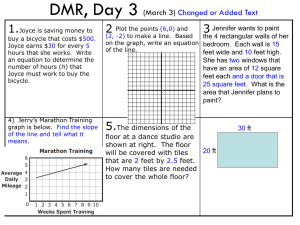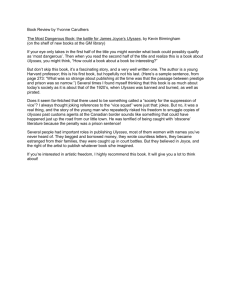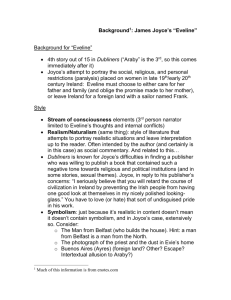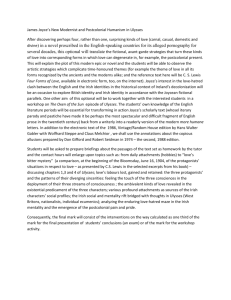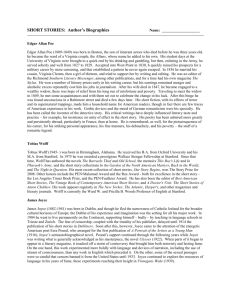to presentation of Memory as a Biological
advertisement
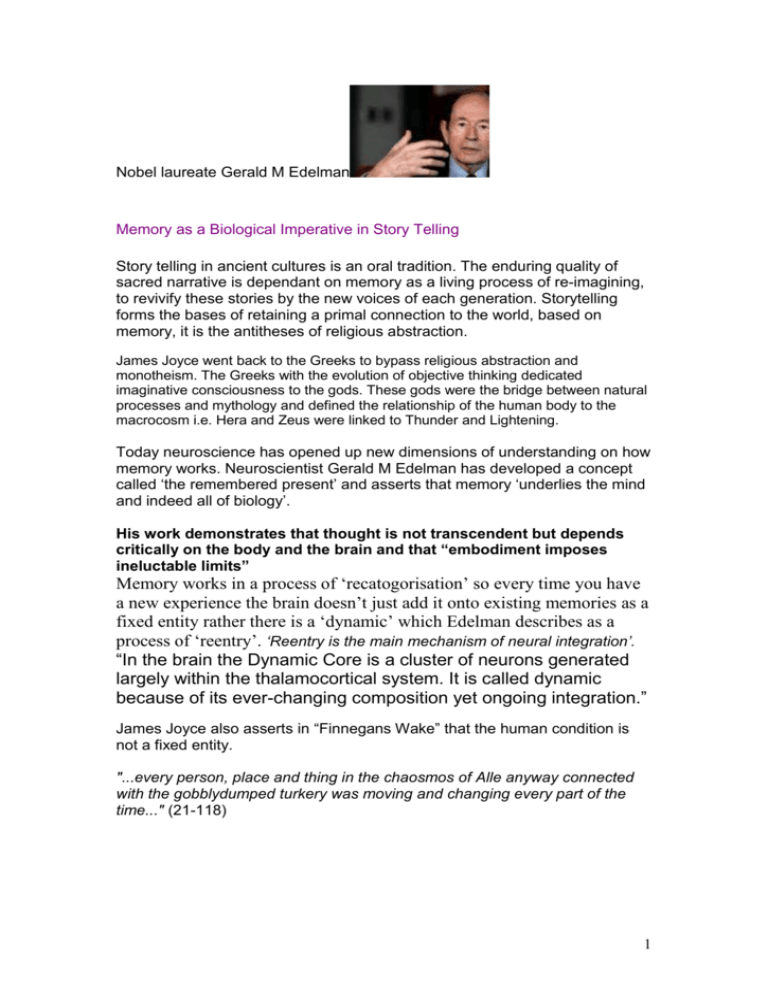
Nobel laureate Gerald M Edelman Memory as a Biological Imperative in Story Telling Story telling in ancient cultures is an oral tradition. The enduring quality of sacred narrative is dependant on memory as a living process of re-imagining, to revivify these stories by the new voices of each generation. Storytelling forms the bases of retaining a primal connection to the world, based on memory, it is the antitheses of religious abstraction. James Joyce went back to the Greeks to bypass religious abstraction and monotheism. The Greeks with the evolution of objective thinking dedicated imaginative consciousness to the gods. These gods were the bridge between natural processes and mythology and defined the relationship of the human body to the macrocosm i.e. Hera and Zeus were linked to Thunder and Lightening. Today neuroscience has opened up new dimensions of understanding on how memory works. Neuroscientist Gerald M Edelman has developed a concept called ‘the remembered present’ and asserts that memory ‘underlies the mind and indeed all of biology’. His work demonstrates that thought is not transcendent but depends critically on the body and the brain and that “embodiment imposes ineluctable limits” Memory works in a process of ‘recatogorisation’ so every time you have a new experience the brain doesn’t just add it onto existing memories as a fixed entity rather there is a ‘dynamic’ which Edelman describes as a process of ‘reentry’. ‘Reentry is the main mechanism of neural integration’. “In the brain the Dynamic Core is a cluster of neurons generated largely within the thalamocortical system. It is called dynamic because of its ever-changing composition yet ongoing integration.” James Joyce also asserts in “Finnegans Wake” that the human condition is not a fixed entity. "...every person, place and thing in the chaosmos of Alle anyway connected with the gobblydumped turkery was moving and changing every part of the time..." (21-118) 1 This paper endeavours in integrate the work of Edelman by a process of ‘recatogorisation’ of past knowledge. Aristotle c. 384 BCE PHILOSOPHY BEGINS WHERE MEDICINE ENDS Joyce studied medicine in Paris 1902. The medical University of Paris 5 was under the patronage of philosopher Rene Descartes. Descartes disagreed with the Scholastic-Aristotelian thesis that all knowledge must come from sensation and asserted the absolute certainty of the clear and distinct ideas perceived by the mind alone. James Joyce left medical school after a few months but continued his interest in medicine especially the boundary between philosophy and medicine and described “Ulysses” published in 1922 as ‘‘the epic of the body”. Joyce used Homer’s “Odysseus” as the prototype for “Ulysses” and in doing so ‘recatogorised’ 20th century abstraction to once again bridge humanity with cosmology. “No single area of the brain is responsible for conscious experience” says Gerald M Edelman. “An Integrated Mental State is not only related to categorization of incoming sensory stimuli –the present-but most important on their interaction with categorical memories-the past.” The concept of ‘reentry’ “ involves widespread synchronization of the activity of different groups of active neurons distributed across many different functionally specialised areas of the brain.” 2 NOVELTY Aliveness is a response to something new… Gerald M.EDELMAN neuroscientist Novelty is the trigger to activate memory and the process of recategorisation St Thomas Aquinas 1225-1274 ‘Patron Saint of Memory’ We marvel more at things which are unusual, and the soul is held by such things more and with greater force. Ted Hughes POET When learning poetry by heart ‘Visual Novelty’ is the key to unfold images that link to syllables that become embodied and go into long term memory. TED Hughes explains that in England in the 17th century, the Puritan/Protestant ascendancy of the Civil War made a serious bid to eradicate imagery from all aspects of life, methodically destroying the religious imagery of churches and forbidding the imaginative play of drama. Rote learning replaced ‘Imagination’ as the bases of learning in schools. 3 DICHOTOMY OF MIND AND BODY James Joyce began writing “Ulysses” in 1907 just as medical breakthroughs dramatically shifted the boundary between medicine and philosophy and in particular scientifically refuted the philosopher Desartes’ dichotomy of mind and body. “I think therefore I am” Rene Descartes 1596 –1650 Descartes asserted the digestion was purely mechanical. Ivan Pavlov 1904 was awarded a Nobel Prize in Medicine. Pavlov demonstrated that the vagus nerve linking the brain with various thoracic and abdominal organs contains fibres, which during their activity stimulate gastric secretion. The secretion of gastric juice is controlled by the central nervous system and can be influenced from different parts of the body. In 1907 Otto Loewi in Vienna established that the transmission of nerve impulses was chemical and not electrical and demonstrated how the Vagus Nerve coming down from the brain manages to get the heart to beat slower. In 4 the same year Johannus Langley, physiologist at Cambridge University labelled the brain in the gut the enteric nervous system (ENS). Giambattista Vico's (1668-1744) had already challenged Rene Descartes’ mind body split on the bases that it killed intuition. “The ancients would not have believed that reason was our first faculty, but on the contrary that imagination was.” Vico’s assertion that Poetry is the primary form of the mind, prior to intellect and free from reflection and reasoning, interested James Joyce and especially Vico’s assertion that “memory is the same as imagination” "imagination is nothing but the springing up again of reminiscences, and ingenuity or invention is nothing but the working over of what is remembered.” Gerald Edelman James Joyce was blatant in his confrontation of René Descartes's dichotomy between mind and body and combined Vico’s stance with the breakthroughs in medical science to write his ’epic of the body’. James Joyce 1882 1941 5 "If they had no body they would have no mind” James Joyce Gerald M Edelman Edelman imagines memory as more like “the melting and refreezing of a glacier than an inscription on a rock.” Zhuangzi (Chuang Tzu) lived in Honan 370-286 BC Zhuangzi provides an interesting perspective from China’s unbroken poetic tradition. “It is for the meaning that the word exists, once you’ve got the meaning, you forget the word, where can I find the man who will forget words so that I can have a word with him?” “to keep the inner memory but not the outer form” "Thus the unfacts, did we possess them, are too imprecisely few to warrant our certitude, the evidencegivers by legpoll too untrustworthily irreperible..."(16-57) “Finnegans Wake’ James Joyce 6 The imagination lives in an "Everpresence”, beyond time." Hart Crane’s writing of “The Bridge” ran parallel to the first serialisation of Joyce’s “Finnegans Wake” in Paris (1932). Crane gives us a wonderful description of how memory and imagination work. The creative process is an organic one, in which the poet submits to external sensations, assimilates and reorganizes them, then represents to the world the "incarnate evidence" of this experience embodied in a poem. The process is organic rather than mechanical because it involves a real grafting of poet and experience rather than a mere shifting of categories in the reflective mind. The poet, then, does not ignore or neglect the past, but revivifies it through incorporation into his imagination's life. The "reorganization of chaos" into a "system," is the goal and function of the imagination, and results in "the moment made eternal" in the continuing life of a poem. “The form of my poem rises out of a past that so overwhelms the present with its worth and vision that I'm at a loss to explain my delusion… The circular structure of the dramatic narrative allows the poem to move, not from past to present, but through the present to the ‘Everpresence’ beyond time.” Su SHI 1037-1101 “The word that has an end but an endless meaning is the supreme word” 7 STORY TELLING James JOYCE was never a creator ex nihilo; he recomposed what he remembered, and he remembered most of what he had seen or had heard other people remember James Joyce described imagination as the constant reworking of the material of memory. It is this reworking faculty that makes memory something creative, something sacred. Otherwise it is just like a really good scrapbook. Samuel Beckett Beckett dismisses voluntary memory, calling it worse than useless as an indicator of the self. Beckett calls voluntary memory, “the memory that is not memory but the application of a concordance to the Old Testament of the individual and lacks revelation, it risks setting itself up as a false idol. Real memory, the residue of “inattention,”is involuntary. It steals upon a person when least expected, and with it brings the past to mingle with the present. Time is therefore undone, because the real secret of involuntary memory is the strength that makes us actually relive the past again.” 8 Psychoanalysis began with a Fairy Tale Bertha Pappenheim Anna O. was Joseph Breuer's patient from 1880 through 1882. Sigmund Freud was a student working with the eminent neurophysiologist at the University of Vienna. Joseph Breuer 1842 -1925 Breuer recognized that Anna O’ could relieve her distress by making up and telling fairy tales, ‘always sad and some of them very charming’ and he encouraged her to do so. She herself called this activity ‘chimney sweeping’ or her ‘talking cure’. Anna used telling fairy tales to free her imagination and thereby facilitate her ‘recatogarisation’ process so she could then move onto the memories that were not integrated and causing physical symptoms. Freuds’s focus on content bypassed the ‘magic of fairytale’ to play with imagination and memory and this being a catalyst towards integrating traumatic experiences within a ‘remembered present’. “Every act of perception is, to some extent an act of creation and every act of memory is, to some degree an act of imagination.” Biological Memory is thus creative and not strictly replicative. Gerald M Edelman 9 The spoken word or an oral tradition of storytelling is a prerequisite to facilitate “Memory as a Living Entity” ‘Coffined thoughts surround me’, Stephen Dedalus reflects in the National Library in Dublin looking at shelves of books. “Ulysses” James Joyce "One great part of every human existence is passed in a state which cannot be rendered sensible by the use of wideawake language, cutanddry grammar, and goahead plot" James Joyce The Spanish writer Lorca distrusted ‘finished writing’ and believed live audiences increased resonant utterances. Lorca used the concept of Duende a fairy or goblin-like creature in Spanish mythology to explore the perennial contradiction between a longing for form and order and a respect for chaos. The philosopher Ludwig Wittgenstein at Cambridge formulated his most coherent ideas talking with his students rather than writing them down and he worked from memory. 10 Sigmund Freud 1856-1939 Freud reconstructed repressed memories through interpretation and freeassociation as the central "technique" of psychoanalysis. He worked to interpret symbolism in dreams and “make the unconscious conscious." Our ability to recatogorise our memories as a living process is what is vital to mental health whereas the content is as varied and endless as the individual human condition. William James described Consciousness not as a substance but as ‘PROCESS’ and Edelman considers this distinction his greatest achievement and links it with his concept of an integrated mental State as a ‘remembered present’ “I want to look at mental diseases as adaptations, as reintegrations of the self under crippling conditions” Freud’s work with repressed memory and dreams was to bring ‘content’ into consciousness and this would have, by default, resulted in some ‘recatogoristion’ by the patient. James Joyce rejected the work of Sigmund Freud. ‘In Ulysses I have recorded, simultaneously, what a man says, sees, thinks, and what such seeing, thinking, saying, does to what you Freudians call the subconscious—but as for psychoanalysis, it’s neither more nor less than blackmail’. “I can psoakoonalouse myself any time I want (the fog follow you all!) without your interferences or any other pigeonstealer” (FW 522). “Ulysses” was banned for 10 years because of the content of Molly Bloom’s stream of consciousness but the actual process is what is interesting as Molly considers, ponders, recollects, wonders and thinks back over her life, she recatagorizes all of her memories. 11 Smell stimulates the Vagus Nerve and is a vital part of Memory 2004 one hundred years exactly after Pavlov two other scientists were awarded the Nobel Prize for their work on the Vagus Nerve The vagus starts in the brainstem, carries messages about the body's physiological state up to the brain. When the body’s arousal level goes up whether due to fear or elation, anger or anticipation those messages somehow cue the brain to make the memory of that moment stronger. Linda B Buck Richard Axel “Odorant Patterns …are the bases of our ability to recognise and form memories of approximately 10,000 different odours.” They discovered a large gene family, comprised of some 1,000 different genes (three per cent of our genes) that give rise to an equivalent number of olfactory receptor types. Regulating the Strength of Memory Work by University of Virginia psychobiologists Cedric L.Williams, PhD, Derrick Hassert, PhD, and Teiko Miyashita, PhD concludes that the vagus nerve is the "missing link" between the hormone epinephrine outside the brain and the neurotransmitter norepinephrine inside the brain. The Vagus Nerve via epinephrine carries messages about the body's physiological state to the Locus Coeruleus in the brain stem. The Locus Coeruleus in the brain stem is the junction where these sensory messages increase norepinephrine secretion which goes to the thalamocorticol centre and activates the process of recatagorisation. 12 At the University of Arizona,Jessica D. Payne and Lynn Nadell are exploring sleep, dreams, and memory consolidation and have shown that variations in cortisol (and other neurotransmitters) determine the functional status of hippocampal-neocortical circuits, thereby influencing the memory consolidation processes that transpire during sleep. Depression and Schizophrenia both of which result in raised CORTISOL disrupts normal hippcampal-neocortical communication and interferes with memory consolidation. In the same way as scientific breakthroughs on the vagus nerve moved the frontier between medicine and philosophy as defined by Aristotle in the early 20th century, Edelman’s concept of memory as recatogorisation when linked to this work on the Vagus nerve has the potential to bring about another major shift in the 21st century. The challenge will be to think it through or ground it in cosmology and this at many levels returns us to story telling and the great ecological consciousness as a dynamic in oral story telling. This map retraces the Journey of Odysseus, master mariner and Homer’s Odyssey is as timeless as the wind and the sea. Louis le Brocquy illustrator “The Tain” is an Irish epic from the 8th century in which topography is a major element. Often the justification for the inclusion of an incident is that it ends in the naming of some place i.e. the final battle is treated very casually while attention is directed in detail to the wanderings of the mortally wounded Donn Cuailinge around Ireland, naming the places as he goes. 13 ULYSSES map of Dublin LEOPOLD BLOOM WALKS through DUBLIN 14 MEMORY and DREAMING are integral to the culture and identity of Aboriginal Australia. Djon Mundine, Bundjalung man and Aboriginal Art Curator says: “What we draw on from our memories, and think, imagine and create in our daily lives is our dreaming.” Dickie Minyintiri a senior Pitjantjatjara men Australian Dickie Minyintiri won the 2011 National Aboriginal & Torres Strait Islander Art Award. The artwork shows tracks of kangaroos, dogs and emu coming to a water hole to drink, and each layer and line is a memory Minyintiri has of a journey he has undertaken. Judges of the award said Minyintiri's painting was a "spontaneous and multi-layered" expression of the winner's relationship to his country... The move from abstraction back to memory and imagination as a living entity is already held in the work of writers such as Joyce, Crane and Lorca. Edelman at the forefront of neuroscience can help us make sense of Aboriginal concepts of memory as a living process of re-imagining. Our Australian struggle to bring about significant change in Aboriginal communities is a reflection of a culture that absorbs change only via ‘dreaming’ and so the segmented nature of ‘western interventions’ can therefore never be integrated ...it is a chasm that will only be bridged when we find a way to be ‘good dreamers together’.The starting and finishing point for such ‘recatogorisation’ is cosmology. In “Finnegans Wake” Joyce is telling us to go back to the earth…the ‘claybook’. “(Stoop) if you are abcedminded, to this claybook, what curios of signs (please stoop), in this allaphbed! Can you rede (since We and Thou had it out 15 already) its world? It is the same told of all. Many. Miscegenations on miscegenations. Tieckle. They lived und laughed ant loved end left.” 16 17 18
